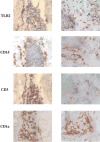Activation of toll-like receptor 2 in acne triggers inflammatory cytokine responses
- PMID: 12133981
- PMCID: PMC4636337
- DOI: 10.4049/jimmunol.169.3.1535
Activation of toll-like receptor 2 in acne triggers inflammatory cytokine responses
Abstract
One of the factors that contributes to the pathogenesis of acne is Propionibacterium acnes; yet, the molecular mechanism by which P. acnes induces inflammation is not known. Recent studies have demonstrated that microbial agents trigger cytokine responses via Toll-like receptors (TLRs). We investigated whether TLR2 mediates P. acnes-induced cytokine production in acne. Transfection of TLR2 into a nonresponsive cell line was sufficient for NF-kappa B activation in response to P. acnes. In addition, peritoneal macrophages from wild-type, TLR6 knockout, and TLR1 knockout mice, but not TLR2 knockout mice, produced IL-6 in response to P. acnes. P. acnes also induced activation of IL-12 p40 promoter activity via TLR2. Furthermore, P. acnes induced IL-12 and IL-8 protein production by primary human monocytes and this cytokine production was inhibited by anti-TLR2 blocking Ab. Finally, in acne lesions, TLR2 was expressed on the cell surface of macrophages surrounding pilosebaceous follicles. These data suggest that P. acnes triggers inflammatory cytokine responses in acne by activation of TLR2. As such, TLR2 may provide a novel target for treatment of this common skin disease.
Figures


 ). Transfected cells were stimulated with P. acnes sonicate or M. tuberculosis 19-kDa lipoprotein, or left unstimulated (□) for 24 h. Activation of IL-12 p40 promoter activity was measured according to CAT activity (percent chloramphenicol acetylation) with a phosphor imager. Data reflects at least two independent experiments and are reported as a percentage of Ag-stimulated IL-12 p40 promoter activity cotransfected with a vector control. Media controls were comparable between vector control and TLR2 dn1 transfectants.
). Transfected cells were stimulated with P. acnes sonicate or M. tuberculosis 19-kDa lipoprotein, or left unstimulated (□) for 24 h. Activation of IL-12 p40 promoter activity was measured according to CAT activity (percent chloramphenicol acetylation) with a phosphor imager. Data reflects at least two independent experiments and are reported as a percentage of Ag-stimulated IL-12 p40 promoter activity cotransfected with a vector control. Media controls were comparable between vector control and TLR2 dn1 transfectants.



References
-
- Leyden JJ, McGinley KJ, Mills OH, Kligman AM. Propionibacterium levels in patients with and without acne vulgaris. J Invest Dermatol. 1975;65:382. - PubMed
-
- Kamisango K, Saiki I, Tanio Y, Okumura H, Araki Y, Sekikawa I, Azuma I, Yamamura Y. Structures and biological activities of peptidoglycans of Listeria monocytogenes and Propionibacterium acnes. J Biochem. 1982;92:23. - PubMed
Publication types
MeSH terms
Substances
Grants and funding
LinkOut - more resources
Full Text Sources
Other Literature Sources
Medical
Research Materials

